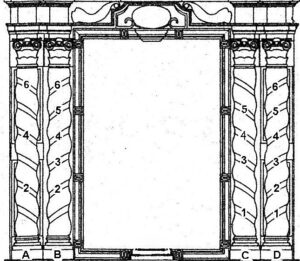Saint Paul’s, the Antwerp Dominican church, a revelation
The Chapel
A small church that is not a parish church. It may be part of a larger entity such as a hospital, school, or an alms-house, or it may stand alone.
An enclosed part of a church with its own altar.
of the Holy SacramentIn Christianity, this is a sacred act in which God comes to man. Sacraments mark important moments in human life. In the Catholic Church, there are seven sacraments: baptism, confession, Eucharist, confirmation, anointing of the sick, marriage and ordination.
and of the Sweet Name of Jesus
The Altar framing (Peter I Verbruggen, 1656)
 Although they are overshadowed by Rubens’ painting, the heavy white marble spiral pillars by Peter I Verbruggen deserve our attention. Angel children, who are in the majority, and putti interchange at random. As is traditional for an altarThe altar is the central piece of furniture used in the Eucharist. Originally, an altar used to be a sacrificial table. This fits in with the theological view that Jesus sacrificed himself, through his death on the cross, to redeem mankind, as symbolically depicted in the painting “The Adoration of the Lamb” by the Van Eyck brothers. In modern times the altar is often described as “the table of the Lord”. Here the altar refers to the table at which Jesus and his disciples were seated at the institution of the Eucharist during the Last Supper. Just as Jesus and his disciples did then, the priest and the faithful gather around this table with bread and wine. (of the Holy Sacrament) they harvest corn and grapes in preparation for the EucharisticThis is the ritual that is the kernel of Mass, recalling what Jesus did the day before he died on the cross. On the evening of that day, Jesus celebrated the Jewish Passover with his disciples. After the meal, he took bread, broke it and gave it to his disciples, saying, “Take and eat. This is my body.” Then he took the cup of wine, gave it to his disciples and said, “Drink from this. This is my blood.” Then Jesus said, “Do this in remembrance of me.” During the Eucharist, the priest repeats these words while breaking bread [in the form of a host] and holding up the chalice with wine. Through the connection between the broken bread and the “broken” Jesus on the cross, Jesus becomes tangibly present. At the same time, this event reminds us of the mission of every Christian: to be “broken bread” from which others can live. gifts of bread and wine, which are represented in the form of a chaliceGilded metal cup, usually on a base, which the priest uses for the wine during the Eucharist. and a large hostA portion of bread made of unleavened wheat flour that, according to Roman Catholic belief, becomes the body of Christ during the Eucharist.. On the left, here to be regarded as chronologically first, on the second level, two putti hit out on each other, which is a composition inspired by Frans du Quesnoy (Rome, ca. 1635). On the same level on the right, to be interpreted as a chronological sequel, two putti reconcile with a kiss, which is repeated above in a warm embrace. A more adequate framing for the real affectionate presence of Jesus in the Eucharist is hard to think of. Does the GospelOne of the four books of the Bible that focus on Jesus’s actions and sayings, his death and resurrection. The four evangelists are Matthew, Mark, Luke, and John. ‘Gospel’ is the Old English translation of the Greek evangeleon, which literally means ‘Good News’. This term refers to the core message of these books. not say: “if you bring your gift to the altar, and there recall that your brotherA male religious who is not a priest. has anything against you, leave your gift there at the altar, go first and be reconciled with your brother, and then come and offer your gift.” (Mth. 5:23,24)? And does Saint PaulOriginally, he was called Saul, he was a Jew with Roman citizenship and a persecutor of Christians in the period shortly after the death of Jesus. After his conversion, he became the main gospel spreader in what is now Turkey and Greece. He wrote letters to keep in touch with the Christian communities he had founded, and these texts are the oldest ones in the New Testament. Although he never met Jesus, he is called an “apostle”. not say (1 Cor. 11:27) that “whoever eats the bread or drinks the cup of the Lord unworthily” – like a fox wanting to eat from the grapes – “will have to answer for the body and blood of the Lord.”? The Sacrament of pure love cannot bear that you are at loggerheads with someone any longer. Singing and music with bagpipe (B5) and shawn represent the joy of meeting Jesus in the Holy Sacrament.
Although they are overshadowed by Rubens’ painting, the heavy white marble spiral pillars by Peter I Verbruggen deserve our attention. Angel children, who are in the majority, and putti interchange at random. As is traditional for an altarThe altar is the central piece of furniture used in the Eucharist. Originally, an altar used to be a sacrificial table. This fits in with the theological view that Jesus sacrificed himself, through his death on the cross, to redeem mankind, as symbolically depicted in the painting “The Adoration of the Lamb” by the Van Eyck brothers. In modern times the altar is often described as “the table of the Lord”. Here the altar refers to the table at which Jesus and his disciples were seated at the institution of the Eucharist during the Last Supper. Just as Jesus and his disciples did then, the priest and the faithful gather around this table with bread and wine. (of the Holy Sacrament) they harvest corn and grapes in preparation for the EucharisticThis is the ritual that is the kernel of Mass, recalling what Jesus did the day before he died on the cross. On the evening of that day, Jesus celebrated the Jewish Passover with his disciples. After the meal, he took bread, broke it and gave it to his disciples, saying, “Take and eat. This is my body.” Then he took the cup of wine, gave it to his disciples and said, “Drink from this. This is my blood.” Then Jesus said, “Do this in remembrance of me.” During the Eucharist, the priest repeats these words while breaking bread [in the form of a host] and holding up the chalice with wine. Through the connection between the broken bread and the “broken” Jesus on the cross, Jesus becomes tangibly present. At the same time, this event reminds us of the mission of every Christian: to be “broken bread” from which others can live. gifts of bread and wine, which are represented in the form of a chaliceGilded metal cup, usually on a base, which the priest uses for the wine during the Eucharist. and a large hostA portion of bread made of unleavened wheat flour that, according to Roman Catholic belief, becomes the body of Christ during the Eucharist.. On the left, here to be regarded as chronologically first, on the second level, two putti hit out on each other, which is a composition inspired by Frans du Quesnoy (Rome, ca. 1635). On the same level on the right, to be interpreted as a chronological sequel, two putti reconcile with a kiss, which is repeated above in a warm embrace. A more adequate framing for the real affectionate presence of Jesus in the Eucharist is hard to think of. Does the GospelOne of the four books of the Bible that focus on Jesus’s actions and sayings, his death and resurrection. The four evangelists are Matthew, Mark, Luke, and John. ‘Gospel’ is the Old English translation of the Greek evangeleon, which literally means ‘Good News’. This term refers to the core message of these books. not say: “if you bring your gift to the altar, and there recall that your brotherA male religious who is not a priest. has anything against you, leave your gift there at the altar, go first and be reconciled with your brother, and then come and offer your gift.” (Mth. 5:23,24)? And does Saint PaulOriginally, he was called Saul, he was a Jew with Roman citizenship and a persecutor of Christians in the period shortly after the death of Jesus. After his conversion, he became the main gospel spreader in what is now Turkey and Greece. He wrote letters to keep in touch with the Christian communities he had founded, and these texts are the oldest ones in the New Testament. Although he never met Jesus, he is called an “apostle”. not say (1 Cor. 11:27) that “whoever eats the bread or drinks the cup of the Lord unworthily” – like a fox wanting to eat from the grapes – “will have to answer for the body and blood of the Lord.”? The Sacrament of pure love cannot bear that you are at loggerheads with someone any longer. Singing and music with bagpipe (B5) and shawn represent the joy of meeting Jesus in the Holy Sacrament.
On the left a dog threatens a squirrel, while on the right the same animal can nibble a fruit without being disturbed. What is the deeper meaning of this?
| Level | Pillar A | Pillar B | Pillar C | Pillar D |
| 6 | bird (phoenix?) | angel sings from a book and keeps time | ? | harvest |
| 5 | angel plays the bagpipe | angel with a chalice and a host | rest during harvest | |
| 4 | angel wants to prevent a fox from eating from grapes | putto plays the shawn | harvest | putti embrace in reconciliation |
| 3 | angel scares with a mask, putto fall backward from fright | cross with a crown of thorns | squirrels nibbles a fruit | |
| 2 | fighting angels | angel protects a squirrel against a dog | putti kiss in reconciliation | |
| 1 | rooster (with a large tail) | harvest |
On the bases of the pillars are the busts of two Dominicans. On the left, i.e. iconographically right – at the place of honour – the devotion to the Holy Sacrament is represented by the bust of Thomas Aquinas, the author of the Eucharistic Hymns. On his cope is his personal attribute, the sun as a symbol of truth. On the right there is the mystic Henry Suso (ca. 1295 Uebelingen or Konstanz, † Ulm 1366; though only beatified in 1831). He was a zealous advocate of the devotion of the Sweet Name of Jesus, as an atonement for the disrespectful usage of Jesus’ name. According to his vita he had inscribed the name of Jesus as a monogram on his chest. Here we see the “IHS” monogram on Suso’s Dominican cape.
In the crowning of the altar the infant Jesus triumphs over evil.

